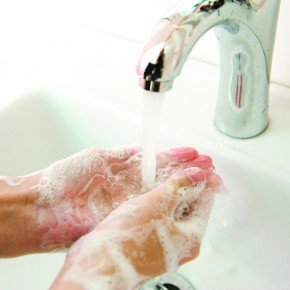
UK urged to wise-up on water consumption
 Climate change, population growth and developing urban landscapes have resulted in serious domestic water issues that, when coupled with energy conservation, will change how we value water and consume energy.
Climate change, population growth and developing urban landscapes have resulted in serious domestic water issues that, when coupled with energy conservation, will change how we value water and consume energy.
Peter Agneborn director, HVAC and commercial buildings business unit at Xylem, explores the severity of the situation in the UK and looks at how we can address it…
Water is an essential part of everyday life, used to heat our homes, clean our clothes and water our gardens. If we are to continue to enjoy high quality water and a constant supply, it is imperative that we find ways of using water more efficiently and sustainably to meet future demand.
Hosepipe bans and droughts are becoming more commonplace during the British summertime, but this only reflects the tip of the iceberg when it comes to water issues.
The UK is already struggling to conserve enough water to serve the increasing population and predictions show that rainfall alone won’t be able to rectify the situation. In the UK, each person uses an average of 150L of water per day, over a tonne a week, compared to water-conscious continental counterparts in Europe who consume as little as 100L per day.
In the last decade, UK Government has introduced a number of pieces of legislation to help consumers and wider industry combat the issue of inefficiency.
From the Building Regulations to the Code for Sustainable Homes and the Energy Related Performance Directive – the responsibility is on both manufacturers and consumers to help reduce consumption on a national scale.
Manufacturers have a responsibility to create new and improved efficiency technology, which Government must regulate for and incentivise within the market place. The consumer must then begin to alter their behaviour, to an extent, in order to bring about a full scale evolution – certainly not an easy task but something that must be done.
It is important to remember that the UK Government isn’t only committed to reducing water usage, but also tightening the regulations for energy efficiency to achieve a zero carbon standard for new homes by 2016.
Bear in mind that water use, and in particular hot water use, has a significant carbon cost, which has led to the Government introducing a host of legislative initiatives, such as the Green Deal, to encourage homeowners to implement energy efficient technologies in the home.
The main aim of the Government’s flagship Green Deal programme is to reduce energy usage and save homeowners money, yet some of the technologies can also have an impact on water consumption, such as efficient showerheads and taps, as well as dual flush devices.
Another technology that offers efficient water use is the circulator pump. Approximately one million domestic circulator pumps are sold in the UK every year, both stand-alone and those which are integrated within boilers by the OEM sector, offering homeowner’s annual savings of between £63 and £89. Based on this information, if every UK household was to replace an inefficient circulator with a modern high efficiency model, it would be possible to close an entire coal-fired power station.
It is clear therefore, that the replacement of inefficient circulator pumps not only offers a great opportunity for domestic energy saving, but it also enables more efficient water use and, ultimately, is a good step towards meeting carbon reduction targets.
In large domestic dwellings and the vast majority of multi-storey housing accommodations, a water booster set is required to ensure that the water is pressurised sufficiently to reach all points of use. The issue with this is that traditional booster sets work at a fixed speed, meaning the level of energy consumed remains the same, even when demand for water is low.
This is especially prominent in a building where there is a dramatic difference in peak and low demand times – a common factor in domestic multi-storey buildings.
Changing a conventional fixed speed unit into a variable speed booster set can deliver a reduction of up to 50% on energy consumption in an instant, by ensuring that the pump only delivers the pressure that is required around the clock which, in-turn, delivers substantial monetary savings.
Also, the pump will meet demand at a constant pressure, regardless of other sanitary fittings being used in the household. But how easy is it to convert a traditional system from fixed to variable speed?
Many plug-and-play variable speed drives are universally compatible and can be retrofitted to any existing booster set, with some manufacturers guaranteeing a pay-back period of less than two years.
Installation of many modern variable speed drives is quick and easy and, once complete, the system will communicate electronically to ensure that it ramps up and down depending on customer demand.
With just the right amount of energy being consumed, the bill payer is no longer covering the cost of the original fixed speed system which uses a continual amount of pressure, even when demand was low. However, consumers and installers can be sure that their variable speed system is running at its most efficient thanks to a slow ramp up time and use of smaller expansion vessels.
It is simple to see that even the smallest adjustments to how a domestic heating and hot water system operates can deliver lower carbon emissions and, most importantly, reduce energy usage through effective water use.
For example, by upgrading a hot water circulator pump to a high efficiency model, consumers can save up to 90% of electricity costs when compared to the consumption of a 60W standard pump.
Needless to say, it is in all our best interests to use water wisely. It may be that in the future, as water demand increases with population growth, we look to alternative water sources, such as rainwater or groundwater.
It is important to remember that water conservation is ultimately our personal responsibility and, since each of us depends on water to perform everyday tasks, it is also our duty therefore, to learn more about water conservation and the technologies available that can help reduce energy usage and thus help us to use water more effectively.
Read more in the December issue of ABC+D Magazine
Latest news

21st February 2025
ASSA ABLOY EMEIA: Save valuable time and money with a seamless switch to programmable digital keys
In 2025, access management can be a whole lot easier. By making access part of their digital processes, businesses can put time-consuming key management and the cost of changing the locks firmly behind them. Making this switch is a lot easier than many people think, as ASSA ABLOY explains here…
Posted in Access Control & Door Entry Systems, Architectural Ironmongery, Articles, Building Industry News, Building Products & Structures, Building Services, Doors, Facility Management & Building Services, Health & Safety, Information Technology, Innovations & New Products, Retrofit & Renovation, Security and Fire Protection
21st February 2025
Showersave supports industry leaders in addressing Part L and Part G regulations
Showersave has sponsored and participated in a recent Building Insights LIVE roundtable on ‘Water & Energy Saving Innovations in New Build Housing’.
Posted in Articles, Bathrooms & Toilets, Bathrooms, Bedrooms & Washrooms, Building Associations & Institutes, Building Industry Events, Building Industry News, Building Products & Structures, Building Regulations & Accreditations, Building Services, Exhibitions and Conferences, Interiors, Pipes & Fittings, Plumbing, Retrofit & Renovation, Sustainability & Energy Efficiency
21st February 2025
GEZE: The importance of Specifying High Quality Door Closers on Fire Doors
Andy Howland, Sales & Marketing Director at GEZE UK, discusses why specifying high quality door closers on fire doors is important…
Posted in Access Control & Door Entry Systems, Accessibility, Architectural Ironmongery, Articles, Building Industry News, Building Products & Structures, Building Regulations & Accreditations, Building Services, Doors, Facility Management & Building Services, Health & Safety, Posts, Restoration & Refurbishment, Retrofit & Renovation, Security and Fire Protection
21st February 2025
Insight Data achieves ISO9001 recertification with zero non-conformities
Leading industry data specialist, Insight Data, has successfully achieved the prestigious recertification for ISO9001 with zero non-conformities for the fourth consecutive year.
Posted in Articles, Building Industry News, Building Regulations & Accreditations, Building Services, Information Technology, Research & Materials Testing
 Sign up:
Sign up: